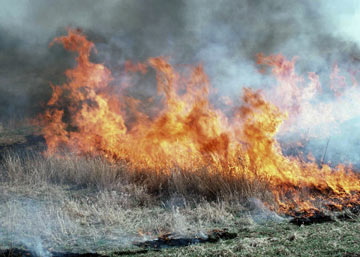Interesting Facts
We decided to make a website about Bromus tectorum because it was an organism that we did not know much about, but are constantly exposed to in the area that we live. The more we researched, the more interesting the species became. Bromus tectorum is an invasive species that is becoming somewhat problematic because of how aggressive it is. The presence of Cheatgrass in its non-native habitats increases the fire frequency (Speziale et al. 2013).
Cheatgrass is not readily ignitable until it reaches the
straw-colored stage. It takes eight to twenty-three days for the moisture content
to drop from 100% to 30%, but on average it takes fourteen days. The
purple coloration of the grass is a warning sign to the hazardous
fire conditions that are about to be possible (Zouhar 2003).
Cheatgrass was classified as a noxious weed or weed seed in two
states in the U.S. and three Canadian provinces in 2003 (Zouhar 2003).
 Fuel breaks can be created to delay the flow of wild fires
through a process called greenstripping. It tends to increase
the breaks between fires on land that is invaded by Cheatgrass.
Fuel breaks can be created to delay the flow of wild fires
through a process called greenstripping. It tends to increase
the breaks between fires on land that is invaded by Cheatgrass.
These fuel breaks are thirty to four hundred feet wide, and are seeded with fire-resistant vegetation and reduce wildfire spread by doing three different things: 1) disrupting fuel continuity 2) reducing fuel accumulations and volatility, and 3) increasing the density of plants with high moisture and low volatile oil content (Zouhar 2003).
Even though Cheatgrass is so intrusive in environments, there methods in which the grass can be controlled. These methods include prescribed burning, grazing, and biological control (“Global Invasive Species Database” 2005; CalIPC 2014).
Prescribed burning is using fire to control or maintain the land; for Cheatgrass this must be done in late spring because it has the chance to kill the seedbank, giving other species the opportunity to grow.
Allowing animals to graze in late fall or early spring is another method that aids in the control of Cheatgrass.
Bromus tectorum is competitive by nature; biological control is a planting other grasses to compete with Cheatgrass. In North America, Crested Wheatgrass may be planted to compete with Bromus tectorum (“Global Invasive Species Database” 2005).
Cheatgrass tends to do better under conditions with high levels
of nitrogen available (Zouhar 2003).
Live Cheatgrass plants are difficult to burn while they are still
green, however, at this stage they are still susceptible to heat.
Cheatgra ss plants are dead once they are dry enough to burn and they
have already done their job of dropping seeds (Zouhar 2003).
ss plants are dead once they are dry enough to burn and they
have already done their job of dropping seeds (Zouhar 2003).
For human uses it is suggested that the Cahuilla considered Cheatgrass
a famine food. Seeds are gathered in quantity and then cooked into
gruel (Zouhar 2003).
An estimated forty-six million acres of winter wheat has been invaded by
Cheatgrass which cost growers about $300 million annually in lost
crop yield. After that, the growers still spend an additional $70
million in herbicides to control the weed (Forest and Range 2006).
Over twenty diseases of Cheatgrass have been reported (Zouhar 2003).
It is such an invasive species that some areas of the world are
trying to control how rapidly it spreads by using prescribed fires
(Zouhar 2003).
Cheatgrass is a major component in the diet of many upland game
birds, like the chukar. As Cheatgrass continues to invade more land
the range of the chukar continues to expand (Zouhar 2003).
Cheatgrass is often infected with a head smut fungus (Ustilago bulleta) that may reduce seed yield when severe. This fungus might be one of the ways we can try to control the spread of this invasive species (Zouhar 2003).
The genus Bromus is composed of one hundred and fifty different grass species (Williams et al. 2011).